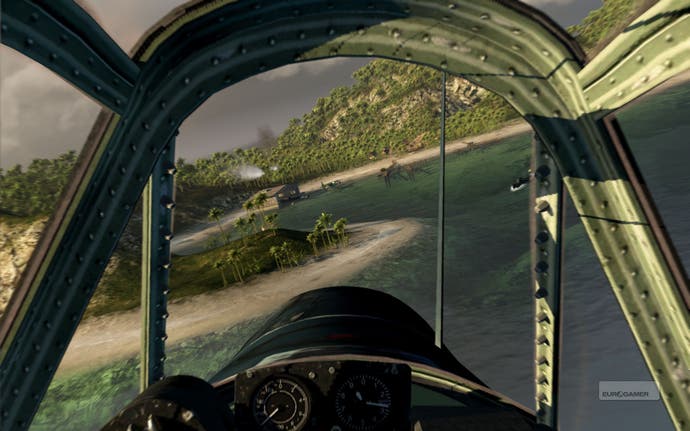Battlestations: Pacific
Plane sailing?
Too many missions involve hauling flotillas of ships sloooowly across the map, before swapping to a shooting gallery to take out your target. Also too common are illogical restrictions on what you have to work with, confining you to a single squadron of planes or one submarine for what amount to rather dull shoot-'em-up sections. The occasionally brilliant missions, the ones in which you're finally free to flex your tactical muscles and really make full use of the various cruisers, destroyers, battleships and carriers, serve as breaths of fresh air that are hugely engrossing but ultimately remind you how stifling the single-player campaigns can be.
The hybrid between action and strategy remains a curious one as well. Most of the time you're able to clinch victory just from the rather bland and rigid tactical map, so the option to hop into the thick of things feels more like a chance to blow off steam than a military necessity. Weapons payloads restock over time, so those keen on realism will have to stick to the multiplayer, where you can switch off such arcade contrivances.
The AI is mostly excellent, which is handy since the options open to you aren't particularly deep. Direct a unit towards an enemy and they'll use the appropriate weapons for the job. Direct them towards a friendly and they'll protect it from harm. Pop in and out of a fighter en route to target and it'll automatically get on with following orders when you skip to the next. All's well and good, except when the AI isn't up to the job, and it's then that you feel the guiding hand of the developer forcing you to do things its way.
One US mission asks you to destroy the beachhead fortifications of a Japanese outpost within a time limit. Even though there's a vast invasion force on the map, including an aircraft carrier, you're granted only a solitary squadron of three fighters to do the job. Do this from the tactical map and you're guaranteed to run out of time. The AI pilots do things by the book, and waste precious minutes tracing wide arcs to circle around for the perfect strafing run for each target. You're left with no choice but to grab the joystick yourself, and given the immense tactical possibilities presented by all the friendly units in the area, being forced into dogfighting feels like an intrusion rather than a thrill.

The game is full of missions like this. A later one sends you after an armoured train, but only in a fighter with a machinegun, even though you had rockets moments before. Why? Because it makes the mission harder. Even though there are clearly other tactical options on the table, you're once again forced to jump through videogame hoops rather than find your own solution.
Graphically the game has improved noticeably, though it won't be troubling any of the benchmark titles. The water effects have predictably received a lot of attention, with undulating waves and transparent shallows. The damage models are also impressive, and in the midst of a raging battle it's genuinely exhilarating to trace a distant enemy plane with your AA cannons and then watch the smoking wreckage plummet into the sea. Such falling debris can cause damage, so it's more than just a cosmetic effect. The lighting is often lovely as well, whether it's used for atmospheric rain-soaked night missions or dazzling dawn raids on sun-kissed islands.
It's not perfect though, with some obvious v-sync tearing and chugging frame-rates accompanying the more impressive displays. Some of the animations also let the side down (witness the way your plane simply vanishes if you crash) while the immersive cockpit views are rather spoiled by the dials and details being nothing more than static images. It's hard to believe you're actually a flying ace when the altimeter is painted on and the joystick in your virtual hands isn't moving.
Battlestations: Pacific still has much to recommend underneath the flaws, much like its predecessor. It's an often clumsy and over-ambitious enterprise, one that can wow you with a pirouette and then slip over on a banana skin in the same mission, but the pleasures it does offer are enhanced by the knowledge that it's still the only game offering them. For all the dozens of gritty, growly WW2 shooters, this is still the only one that seems interested in the fascinating and unique challenges of naval command. It may not deliver those challenges with the aplomb and polish you'd hope, but it's hard to begrudge the attempt.

